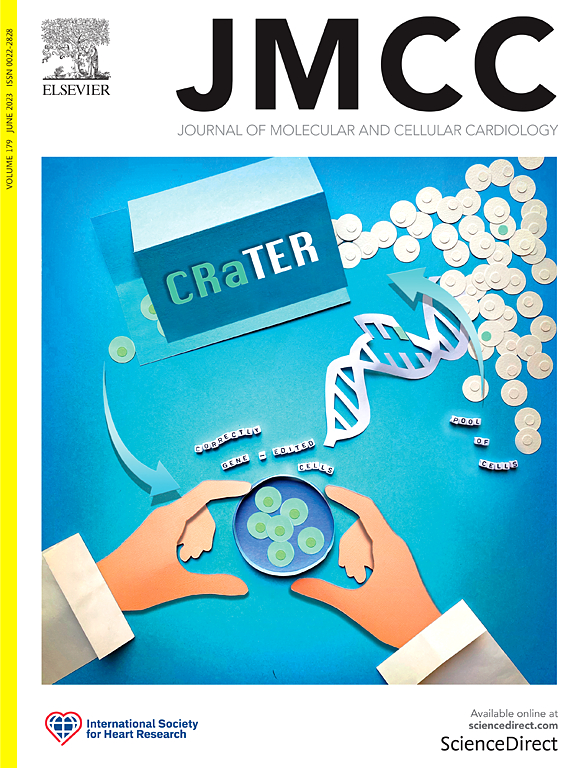在纯合子CRISPR基因编辑的小鼠中,心肌肌球蛋白结合蛋白c的L348P点突变改变了对拉伸的短暂反应,减慢了心脏舒张,并且是胚胎致死的
IF 4.7
2区 医学
Q1 CARDIAC & CARDIOVASCULAR SYSTEMS
引用次数: 0
摘要
心肌肌球蛋白结合蛋白c (cMyBP-C)突变是肥厚性心肌病(HCM)的常见原因,HCM是一种遗传性常染色体显性遗传病,250-500人中有1人患病。我们之前在转基因小鼠cMyBP-C的调控基序(m结构域)中发现了一个单氨基酸取代(L348P),该取代减缓了舒张并导致舒张功能障碍。在这里,我们试图通过创建CRISPR基因编辑敲入小鼠模型(L348P-CR)并使小鼠与突变等位基因纯合来增加突变蛋白的表达。结果显示,L348P-CR纯合小鼠在子宫内死亡,而杂合敲入小鼠出现与转基因小鼠相当的收缩缺陷和舒张功能障碍。为了克服L348P突变的致死性纯合表达,我们使用“剪切-粘贴”方法在SpyC3小鼠的渗透心肌细胞中用重组L348P cMyBP-C完全取代内源性野生型cMyBP-C。结果表明,用重组L348P替代野生型cMyBP-C再现了转基因和L348P- cr小鼠的机械效应,验证了我们的剪切-粘贴方法在评估cMyBP-C功能效应方面的实用性。我们得出结论,L348P-CR敲入小鼠是cMyBP-C单点突变引起的舒张功能障碍的可靠模型,剪切-粘贴方法为评估cMyBP-C突变提供了一种快速且经济有效的方法,特别是那些在传统动物模型中致命的突变。本文章由计算机程序翻译,如有差异,请以英文原文为准。

The L348P point mutation in cardiac myosin binding protein-C alters transient responses to stretch, slows cardiac relaxation, and is embryonic lethal in homozygous CRISPR gene-edited mice
Mutations in cardiac myosin binding protein-C (cMyBP-C) are a common cause of hypertrophic cardiomyopathy (HCM), an inherited autosomal dominant disease affecting 1 in 250–500 people. We previously identified a single amino acid substitution (L348P) in the regulatory motif (M-domain) of cMyBP-C that slowed relaxation and caused diastolic dysfunction in transgenic mice. Here we attempted to increase expression of the mutant protein by creating a CRISPR gene-edited knock-in mouse model (L348P-CR) and breeding mice to homozygosity for the mutant allele. Results showed that L348P-CR homozygous mice died in utero, but that heterozygous knock-in mice developed contractile deficits and diastolic dysfunction comparable to transgenic mice. To overcome the lethal homozygous expression of the L348P mutation, we used our “cut-and-paste” approach to fully replace endogenous wild-type cMyBP-C with recombinant L348P cMyBP-C in permeabilized cardiomyocytes from SpyC3 mice. Results showed that replacement of wild-type cMyBP-C with recombinant L348P recapitulated mechanical effects seen in transgenic and L348P-CR mice, validating the utility of our cut-and-paste method for evaluating functional effects of cMyBP-C. We conclude that L348P-CR knock-in mice are a robust model of diastolic dysfunction due to a single point mutation in cMyBP-C and that the cut-and-paste approach offers a rapid and cost-effective approach for evaluating mutations in cMyBP-C, especially those that are lethal in traditional animal models.
求助全文
通过发布文献求助,成功后即可免费获取论文全文。
去求助
来源期刊
CiteScore
10.70
自引率
0.00%
发文量
171
审稿时长
42 days
期刊介绍:
The Journal of Molecular and Cellular Cardiology publishes work advancing knowledge of the mechanisms responsible for both normal and diseased cardiovascular function. To this end papers are published in all relevant areas. These include (but are not limited to): structural biology; genetics; proteomics; morphology; stem cells; molecular biology; metabolism; biophysics; bioengineering; computational modeling and systems analysis; electrophysiology; pharmacology and physiology. Papers are encouraged with both basic and translational approaches. The journal is directed not only to basic scientists but also to clinical cardiologists who wish to follow the rapidly advancing frontiers of basic knowledge of the heart and circulation.

 求助内容:
求助内容: 应助结果提醒方式:
应助结果提醒方式:


